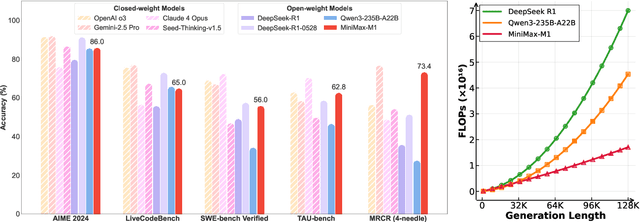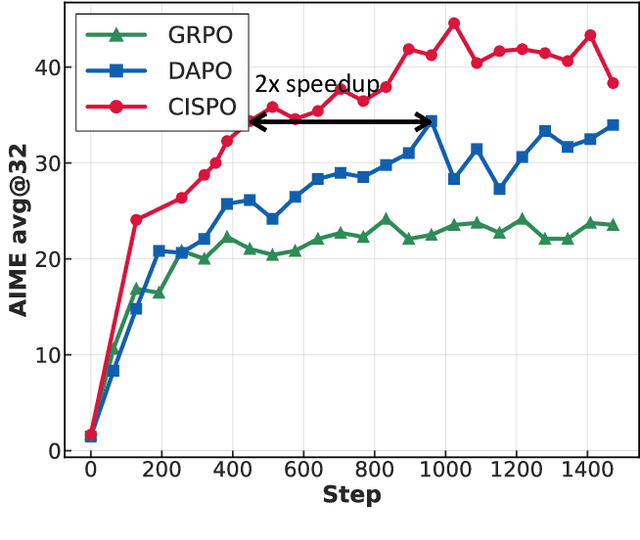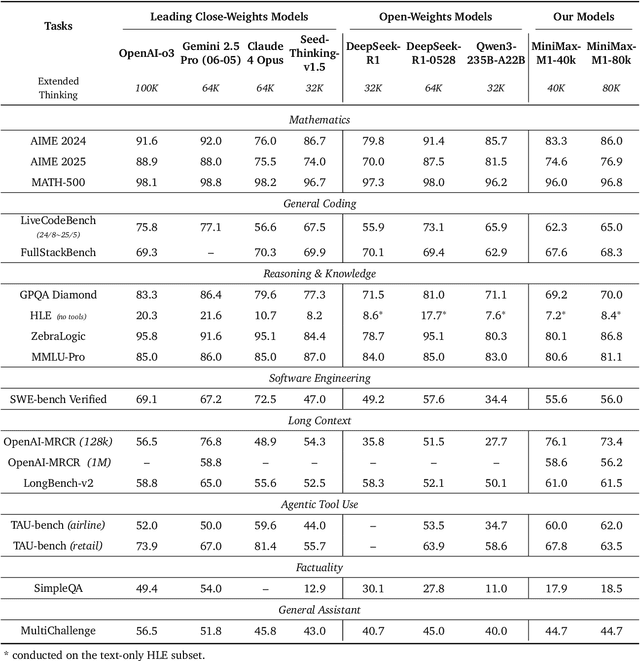Pengfei Li
World In Your Hands: A Large-Scale and Open-source Ecosystem for Learning Human-centric Manipulation in the Wild
Dec 30, 2025Abstract:Large-scale pre-training is fundamental for generalization in language and vision models, but data for dexterous hand manipulation remains limited in scale and diversity, hindering policy generalization. Limited scenario diversity, misaligned modalities, and insufficient benchmarking constrain current human manipulation datasets. To address these gaps, we introduce World In Your Hands (WiYH), a large-scale open-source ecosystem for human-centric manipulation learning. WiYH includes (1) the Oracle Suite, a wearable data collection kit with an auto-labeling pipeline for accurate motion capture; (2) the WiYH Dataset, featuring over 1,000 hours of multi-modal manipulation data across hundreds of skills in diverse real-world scenarios; and (3) extensive annotations and benchmarks supporting tasks from perception to action. Furthermore, experiments based on the WiYH ecosystem show that integrating WiYH's human-centric data significantly enhances the generalization and robustness of dexterous hand policies in tabletop manipulation tasks. We believe that World In Your Hands will bring new insights into human-centric data collection and policy learning to the community.
Fairness-Regularized Online Optimization with Switching Costs
Dec 11, 2025Abstract:Fairness and action smoothness are two crucial considerations in many online optimization problems, but they have yet to be addressed simultaneously. In this paper, we study a new and challenging setting of fairness-regularized smoothed online convex optimization with switching costs. First, to highlight the fundamental challenges introduced by the long-term fairness regularizer evaluated based on the entire sequence of actions, we prove that even without switching costs, no online algorithms can possibly achieve a sublinear regret or finite competitive ratio compared to the offline optimal algorithm as the problem episode length $T$ increases. Then, we propose FairOBD (Fairness-regularized Online Balanced Descent), which reconciles the tension between minimizing the hitting cost, switching cost, and fairness cost. Concretely, FairOBD decomposes the long-term fairness cost into a sequence of online costs by introducing an auxiliary variable and then leverages the auxiliary variable to regularize the online actions for fair outcomes. Based on a new approach to account for switching costs, we prove that FairOBD offers a worst-case asymptotic competitive ratio against a novel benchmark -- the optimal offline algorithm with parameterized constraints -- by considering $T\to\infty$. Finally, we run trace-driven experiments of dynamic computing resource provisioning for socially responsible AI inference to empirically evaluate FairOBD, showing that FairOBD can effectively reduce the total fairness-regularized cost and better promote fair outcomes compared to existing baseline solutions.
Semiparametric Learning from Open-Set Label Shift Data
Sep 18, 2025Abstract:We study the open-set label shift problem, where the test data may include a novel class absent from training. This setting is challenging because both the class proportions and the distribution of the novel class are not identifiable without extra assumptions. Existing approaches often rely on restrictive separability conditions, prior knowledge, or computationally infeasible procedures, and some may lack theoretical guarantees. We propose a semiparametric density ratio model framework that ensures identifiability while allowing overlap between novel and known classes. Within this framework, we develop maximum empirical likelihood estimators and confidence intervals for class proportions, establish their asymptotic validity, and design a stable Expectation-Maximization algorithm for computation. We further construct an approximately optimal classifier based on posterior probabilities with theoretical guarantees. Simulations and a real data application confirm that our methods improve both estimation accuracy and classification performance compared with existing approaches.
A Survey of Reinforcement Learning for Large Reasoning Models
Sep 10, 2025Abstract:In this paper, we survey recent advances in Reinforcement Learning (RL) for reasoning with Large Language Models (LLMs). RL has achieved remarkable success in advancing the frontier of LLM capabilities, particularly in addressing complex logical tasks such as mathematics and coding. As a result, RL has emerged as a foundational methodology for transforming LLMs into LRMs. With the rapid progress of the field, further scaling of RL for LRMs now faces foundational challenges not only in computational resources but also in algorithm design, training data, and infrastructure. To this end, it is timely to revisit the development of this domain, reassess its trajectory, and explore strategies to enhance the scalability of RL toward Artificial SuperIntelligence (ASI). In particular, we examine research applying RL to LLMs and LRMs for reasoning abilities, especially since the release of DeepSeek-R1, including foundational components, core problems, training resources, and downstream applications, to identify future opportunities and directions for this rapidly evolving area. We hope this review will promote future research on RL for broader reasoning models. Github: https://github.com/TsinghuaC3I/Awesome-RL-for-LRMs
MiniMax-M1: Scaling Test-Time Compute Efficiently with Lightning Attention
Jun 16, 2025



Abstract:We introduce MiniMax-M1, the world's first open-weight, large-scale hybrid-attention reasoning model. MiniMax-M1 is powered by a hybrid Mixture-of-Experts (MoE) architecture combined with a lightning attention mechanism. The model is developed based on our previous MiniMax-Text-01 model, which contains a total of 456 billion parameters with 45.9 billion parameters activated per token. The M1 model natively supports a context length of 1 million tokens, 8x the context size of DeepSeek R1. Furthermore, the lightning attention mechanism in MiniMax-M1 enables efficient scaling of test-time compute. These properties make M1 particularly suitable for complex tasks that require processing long inputs and thinking extensively. MiniMax-M1 is trained using large-scale reinforcement learning (RL) on diverse problems including sandbox-based, real-world software engineering environments. In addition to M1's inherent efficiency advantage for RL training, we propose CISPO, a novel RL algorithm to further enhance RL efficiency. CISPO clips importance sampling weights rather than token updates, outperforming other competitive RL variants. Combining hybrid-attention and CISPO enables MiniMax-M1's full RL training on 512 H800 GPUs to complete in only three weeks, with a rental cost of just $534,700. We release two versions of MiniMax-M1 models with 40K and 80K thinking budgets respectively, where the 40K model represents an intermediate phase of the 80K training. Experiments on standard benchmarks show that our models are comparable or superior to strong open-weight models such as the original DeepSeek-R1 and Qwen3-235B, with particular strengths in complex software engineering, tool utilization, and long-context tasks. We publicly release MiniMax-M1 at https://github.com/MiniMax-AI/MiniMax-M1.
TabPFN: One Model to Rule Them All?
May 26, 2025Abstract:Hollmann et al. (Nature 637 (2025) 319-326) recently introduced TabPFN, a transformer-based deep learning model for regression and classification on tabular data, which they claim "outperforms all previous methods on datasets with up to 10,000 samples by a wide margin, using substantially less training time." Furthermore, they have called TabPFN a "foundation model" for tabular data, as it can support "data generation, density estimation, learning reusable embeddings and fine-tuning". If these statements are well-supported, TabPFN may have the potential to supersede existing modeling approaches on a wide range of statistical tasks, mirroring a similar revolution in other areas of artificial intelligence that began with the advent of large language models. In this paper, we provide a tailored explanation of how TabPFN works for a statistics audience, by emphasizing its interpretation as approximate Bayesian inference. We also provide more evidence of TabPFN's "foundation model" capabilities: We show that an out-of-the-box application of TabPFN vastly outperforms specialized state-of-the-art methods for semi-supervised parameter estimation, prediction under covariate shift, and heterogeneous treatment effect estimation. We further show that TabPFN can outperform LASSO at sparse regression and can break a robustness-efficiency trade-off in classification. All experiments can be reproduced using the code provided at https://github.com/qinglong-tian/tabpfn_study (https://github.com/qinglong-tian/tabpfn_study).
FusionTrack: End-to-End Multi-Object Tracking in Arbitrary Multi-View Environment
May 24, 2025Abstract:Multi-view multi-object tracking (MVMOT) has found widespread applications in intelligent transportation, surveillance systems, and urban management. However, existing studies rarely address genuinely free-viewpoint MVMOT systems, which could significantly enhance the flexibility and scalability of cooperative tracking systems. To bridge this gap, we first construct the Multi-Drone Multi-Object Tracking (MDMOT) dataset, captured by mobile drone swarms across diverse real-world scenarios, initially establishing the first benchmark for multi-object tracking in arbitrary multi-view environment. Building upon this foundation, we propose \textbf{FusionTrack}, an end-to-end framework that reasonably integrates tracking and re-identification to leverage multi-view information for robust trajectory association. Extensive experiments on our MDMOT and other benchmark datasets demonstrate that FusionTrack achieves state-of-the-art performance in both single-view and multi-view tracking.
One RL to See Them All: Visual Triple Unified Reinforcement Learning
May 23, 2025Abstract:Reinforcement learning (RL) has significantly advanced the reasoning capabilities of vision-language models (VLMs). However, the use of RL beyond reasoning tasks remains largely unexplored, especially for perceptionintensive tasks like object detection and grounding. We propose V-Triune, a Visual Triple Unified Reinforcement Learning system that enables VLMs to jointly learn visual reasoning and perception tasks within a single training pipeline. V-Triune comprises triple complementary components: Sample-Level Data Formatting (to unify diverse task inputs), Verifier-Level Reward Computation (to deliver custom rewards via specialized verifiers) , and Source-Level Metric Monitoring (to diagnose problems at the data-source level). We further introduce a novel Dynamic IoU reward, which provides adaptive, progressive, and definite feedback for perception tasks handled by V-Triune. Our approach is instantiated within off-the-shelf RL training framework using open-source 7B and 32B backbone models. The resulting model, dubbed Orsta (One RL to See Them All), demonstrates consistent improvements across both reasoning and perception tasks. This broad capability is significantly shaped by its training on a diverse dataset, constructed around four representative visual reasoning tasks (Math, Puzzle, Chart, and Science) and four visual perception tasks (Grounding, Detection, Counting, and OCR). Subsequently, Orsta achieves substantial gains on MEGA-Bench Core, with improvements ranging from +2.1 to an impressive +14.1 across its various 7B and 32B model variants, with performance benefits extending to a wide range of downstream tasks. These results highlight the effectiveness and scalability of our unified RL approach for VLMs. The V-Triune system, along with the Orsta models, is publicly available at https://github.com/MiniMax-AI.
LiloDriver: A Lifelong Learning Framework for Closed-loop Motion Planning in Long-tail Autonomous Driving Scenarios
May 22, 2025Abstract:Recent advances in autonomous driving research towards motion planners that are robust, safe, and adaptive. However, existing rule-based and data-driven planners lack adaptability to long-tail scenarios, while knowledge-driven methods offer strong reasoning but face challenges in representation, control, and real-world evaluation. To address these challenges, we present LiloDriver, a lifelong learning framework for closed-loop motion planning in long-tail autonomous driving scenarios. By integrating large language models (LLMs) with a memory-augmented planner generation system, LiloDriver continuously adapts to new scenarios without retraining. It features a four-stage architecture including perception, scene encoding, memory-based strategy refinement, and LLM-guided reasoning. Evaluated on the nuPlan benchmark, LiloDriver achieves superior performance in both common and rare driving scenarios, outperforming static rule-based and learning-based planners. Our results highlight the effectiveness of combining structured memory and LLM reasoning to enable scalable, human-like motion planning in real-world autonomous driving. Our code is available at https://github.com/Hyan-Yao/LiloDriver.
Effective climate policies for major emission reductions of ozone precursors: Global evidence from two decades
May 20, 2025Abstract:Despite policymakers deploying various tools to mitigate emissions of ozone (O\textsubscript{3}) precursors, such as nitrogen oxides (NO\textsubscript{x}), carbon monoxide (CO), and volatile organic compounds (VOCs), the effectiveness of policy combinations remains uncertain. We employ an integrated framework that couples structural break detection with machine learning to pinpoint effective interventions across the building, electricity, industrial, and transport sectors, identifying treatment effects as abrupt changes without prior assumptions about policy treatment assignment and timing. Applied to two decades of global O\textsubscript{3} precursor emissions data, we detect 78, 77, and 78 structural breaks for NO\textsubscript{x}, CO, and VOCs, corresponding to cumulative emission reductions of 0.96-0.97 Gt, 2.84-2.88 Gt, and 0.47-0.48 Gt, respectively. Sector-level analysis shows that electricity sector structural policies cut NO\textsubscript{x} by up to 32.4\%, while in buildings, developed countries combined adoption subsidies with carbon taxes to achieve 42.7\% CO reductions and developing countries used financing plus fuel taxes to secure 52.3\%. VOCs abatement peaked at 38.5\% when fossil-fuel subsidy reforms were paired with financial incentives. Finally, hybrid strategies merging non-price measures (subsidies, bans, mandates) with pricing instruments delivered up to an additional 10\% co-benefit. These findings guide the sequencing and complementarity of context-specific policy portfolios for O\textsubscript{3} precursor mitigation.
 Add to Chrome
Add to Chrome Add to Firefox
Add to Firefox Add to Edge
Add to Edge